–
子午劍
SUNDIAL SWORD
順德黃漢勛編述
by Huang Hanxun [Wong Honfan] of Shunde
山東蓬萊羅師光玉授
as taught by Luo Guangyu of Penglai, Shandong
校對者:戴金城
text proofread by Dai Jincheng
[published in Hong Kong, 35th year of the cycle, 3rd month, 20th day (May 8, 1958)]
[translation by Paul Brennan, Aug, 2018]
–
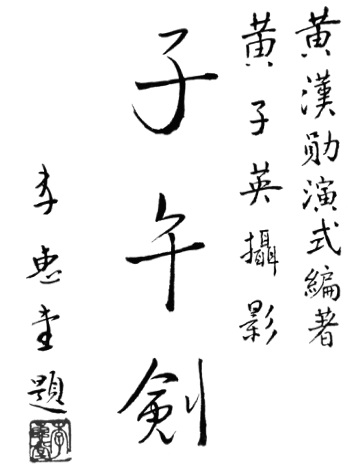
黃漢勛演式編著 黃子英攝影
Written and performed by Huang Hanxun, and photographed by Huang Ziying:
子午剣
Sundial Sword
李惠堂題
– calligraphy by Li Huitang
–
子午劍名稱
NAMES OF THE POSTURES IN THE SUNDIAL SWORD SET
中平佩劍式
[1] STANDING STABLY, HOLDING THE SWORD
白猿問路式
[2] WHITE APE ASKS THE WAY
夜叉探海式
[3] NIGHT DEMON SEARCHES THE SEA
青龍坐窩式
[4] BLUE DRAGON SITS IN ITS LAIR
白蛇吐信式
[5] WHITE SNAKE FLICKS OUT ITS TONGUE
螳螂捕蝉式
[6] MANTIS CATCHES A CICADA
登山提劍式
[7] MOUNTAIN-CLIMBING STANCE, LIFTING THE SWORD
提腿刺劍式
[8] LIFTING LEG, STABBING SWORD
登山提劍式
[9] MOUNTAIN-CLIMBING STANCE, LIFTING THE SWORD
提腿刺劍式
[10] LIFTING LEG, STABBING SWORD
鳳凰初蹶尾
[11] PHOENIX DROPS ITS TAIL – FIRST TIME
鳳凰再蹶尾
[12] PHOENIX DROPS ITS TAIL – SECOND TIME
鳳凰三蹶尾
[13] PHOENIX DROPS ITS TAIL – THIRD TIME
青龍坐窩式
[14] BLUE DRAGON SITS IN ITS LAIR
喜雀躍登枝
[15] HAPPY SPARROW HOPS ONTO A BRANCH
鳳凰坐窩式
[16] PHOENIX SITS IN ITS NEST
金龍大盤柱
[17] GOLDEN DRAGON COILS AROUND THE PILLAR
鳳凰點頭式
[18] PHOENIX NODS ITS HEAD
老僧入定式
[19] MONK GOES INTO A TRANCE
和尚撞金鐘
[20] MONK RINGS THE GOLDEN BELL
鷂子大翻身
[21] HAWK TURNS OVER
呂洞賓斬蛇
[22] LÜ DONGBIN BEHEADS THE SNAKE
蘇秦佩寳劍
[23] SU QIN WEARS HIS PRECIOUS SWORD
鳳凰初點頭
[24] PHOENIX NODS ITS HEAD – FIRST TIME
鳳凰再點頭
[25] PHOENIX NODS ITS HEAD – SECOND TIME
鳳凰三點頭
[26] PHOENIX NODS ITS HEAD – THIRD TIME
金鈎掛玉瓶
[27] THE JADE VASE HANGS FROM THE GOLDEN HOOK
斜步倒掛劍
[28] DIAGONAL STEP, REVERSE HANGING
右步斜刺劍
[29] WALKING TO THE RIGHT, STABBING DIAGONALLY
左走反刺劍
[30] WALKING TO THE LEFT, COUNTERING WITH A STAB
圈劍劈華山
[31] CIRCLING SWORD, CHOP TO MT. HUA
螳螂捕蝉式
[32] MANTIS CATCHES A CICADA
跨虎挑寳劍
[33] SITTING-TIGER STANCE, CARRYING A PRECIOUS SWORD
入環右橫劍
[34] KNEELING STANCE, RIGHT SWINGING SWORD
入環左橫劍
[35] KNEELING STANCE, LEFT SWINGING SWORD
上訣橫門劍
[36] HEXING ABOVE WHILE SENDING THE SWORD ACROSS
提腿刺劍式
[37] LIFTING LEG, STABBING SWORD
扭步劈華山
[38] TWISTING STANCE, CHOP TO MT. HUA
跨虎单展翅
[39] SITTING-TIGER STANCE, SPREADING A SINGLE WING
游龍大擺尾
[40] SWIMMING DRAGON SWINGS ITS TAIL
跨虎劈華山
[41] SITTING-TIGER STANCE, CHOP TO MT. HUA
跨虎倒低挑
[42] SITTING-TIGER STANCE, REVERSE CARRYING
螳螂捕蝉式
[43] MANTIS CATCHES A CICADA
夜义探海式
[44] NIGHT DEMON SEARCHES THE SEA
收劍跨虎式
[45] GATHERING IN THE SWORD, SITTING-TIGER STANCE
立正中平式
[46] STANDING STABLY AT ATTENTION
–
前中央國術館館長 張之江先生題字
Inscription by former director of the Central Martial Arts Institute, Zhang Zhijiang:
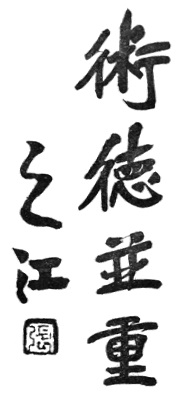
術德並重
“Give equal emphasis to both skill and morality.”
之江
– [Zhang] Zhijiang
–

練藝貴能貫通精氣神
“Practicing these arts will enable the smooth flow of essence, energy, and spirit.”
盧煒昌 漢勛同志囑書卄八、四、四
– inscription by Lu Weichang for my colleague Hanxun, Apr 4, 1939
–
試劍𡇫 黃翔繪
Image of the sword being drawn (drawing by Huang Xiang):
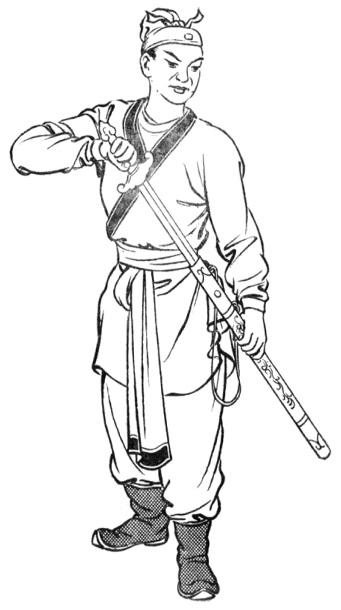
掛劍𡇫 黃翔繪
Image of the sword hanging (drawing by Huang Xiang):
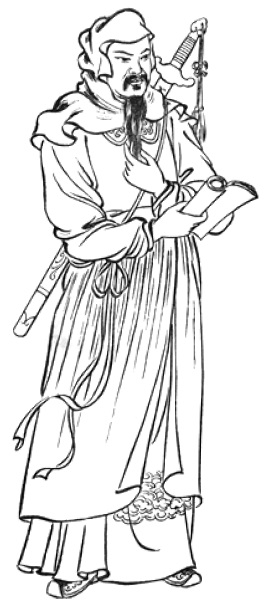
武士试劍𡇫 鄭祥繪
Image of a soldier drawing his sword (drawing by Zheng Xiang):

文士掛劍𡇫 鄭祥繪
Image of a scholar with his sword hanging (drawing by Zheng Xiang):
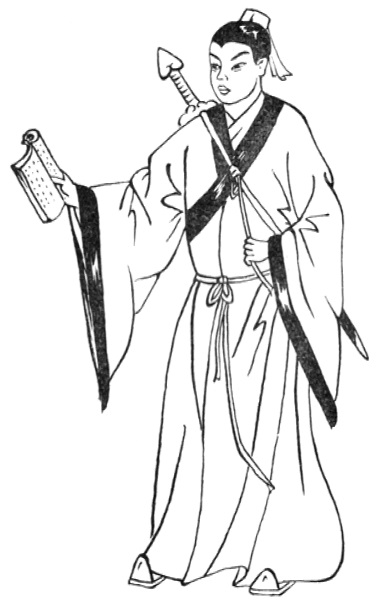
–
自序
AUTHOR’S PREFACE
劍術乃中國武術上最髙妙与神奇之技術,據坊間小說㪽載之「劍俠」「劍仙」之類,可謂玄之又玄,妙之又妙,而敘述其練劍成丸,納諸腹中,吐於千里之外,以取人性命於俄傾之間,若確有此等事寔,則近乎仙矣。
然余站在純技術之立場而言,當否定此等傳説,惟根據前輩學長与近代朋友之練劍,確是一件極艱難之事,練形式之正確与姿態之義妙固難,若求練至精純与運勁於劍端,揮洒自如而達於運用靈巧,則非痛下十年八載苦功不可,如欲達於攻守應敵之境,又非具有天賦聰慧与靈感不可,天聰靈感乃非人力可致,必淂天獨厚方克有成。
余雖曾致力於斯道惟去成功之域遠甚且連年覓食四方乆矣荒疎㪽學子午劍為先師最愛惜之技,昔師生常遊玩於香島半山區之寳雲道,遊必以手杖作劍,擇游龍擺尾与金龍盤柱等式作練習,至晚年(民二十七年)始傳於隨之最乆之數人,至民二十八年秋,囑余草擬告别武壇啓事乙則(收山之意)刊於報端,嗣後即不再公開授人,余今編成此子午劍一書,寔去先師之技千萬里,惟旨在宣傳武化與發揚先師遺技寔未計及佳劣与成敗也。
戊戌仲春上浣於螳螂樓
The sword art is the most ingenious and magical skill in Chinese martial arts, described by the “sword heroes” and “sword immortals” in martial arts fiction as “profound and still more profound” or “so mysterious and yet even more mysterious”. There are tales of sword practitioners making pellets that they swallow into their bellies and then spit to a distance of many hundreds of miles to take a person’s life in an instant. If such things were true, then these people would be “immortals” indeed.
But from the standpoint of pure skill, I deny all such legends. According to old masters and recent colleagues alike, to train in the sword art is an extremely demanding task, for to perform the postures correctly and also with the right degree of subtlety is very difficult indeed. If you want to master sending power all the way to the sword tip, painting the air with naturalness, and wielding the sword with nimbleness, it cannot be done without ten or at least eight years of painstaking effort. And if you want to achieve a condition of being able to use this skill to fight against opponents, it cannot be done unless you possess a natural intelligence and a keen awareness, though as these are things which cannot be developed through sheer effort, you must make use of the qualities you were born with in order to succeed.
I once devoted myself to learning this skill, but was still far from succeeding when I then had to spend several long years [during the war against Japan] just trying to find enough to eat, after which I had become very rusty at even the little that I had learned well. The Sundial Sword set was Master Luo’s most treasured skill. He and his students often used to play with these techniques just off the Bowen Road, halfway up the mountains on Hong Kong Island. We had to use walking sticks as swords and practiced techniques such as SWIMMING DRAGON SWINGS ITS TAIL [Posture 40], GOLDEN DRAGON COILS AROUND THE PILLAR [Posture 17], and so on.
In Luo’s later years (specifically 1938), he started to teach the set to his most loyal students, and then in the autumn of 1939, he told me to advertise it to martial arts circles at large and to follow this with publishing the set in a periodical (with an intention of “piling up a mountain” [i.e. in serialized form]). As it has subsequently not been published again since that time, I have now made this book so that his skills can be spread as far away as possible, thinking only of sharing martial wisdom and of carrying on his teachings, ignoring all doubts over whether what I am doing is of high quality or low, or whether I am succeeding or failing.
- written at the Mantis School, 35th year of the cycle, during the 1st ten-day period of the 2nd month of spring [late March, 1958]
–
第一式 中平佩劍式
Posture 1: STANDING STABLY, HOLDING THE SWORD
説明
Explanation:
假定我以東方作起點,則應站定東方,即右東,左西,面北,背南,目視西方,以俟劍式之展開,双脚緊靠,作中平勢,右手直垂,左隂手持劍,並以左手食指與中指直貼劍把,而成劍訣之形狀,精神集中,無使怠懈,為練拳者之基本要素,持械者更甚焉,幸我同道注意及之如『定式𡇫』。
If you are standing in the eastern part of the practice space to begin this set, then the east is to your right, the west to your left, the north in front of you, and the south behind you. Your gaze is to the west. Before moving, your feet are standing next to each other, making a posture of standing stably. Your right hand is hanging down, your left hand holding the sword with the center of the hand facing behind you, the forefinger and middle finger touching the sword handle and pointing straight, the hand thus making the shape of a “swordsman’s hex”. Your spirit should be concentrated within and not allowed to slacken. This is an essential factor in practicing the boxing sets, and is even more crucial when holding a weapon [so that a slip in concentration does not result in injuring yourself]. I hope my fellow practitioners will pay attention to this point. See photo 1:

功用:
Application:
劍式尚未展開,故無功用可言。
In this posture, you have not yet reached out with the sword, and thus there is no application to speak of.
第二式 白猿問路式
Posture 2: WHITE APE ASKS THE WAY
説明
Explanation:
循上式,原式未動,祗以右手劍訣斜提起於頭上,如『過渡式甲圗』。
Continuing from the previous posture, without changing your position, move only your right hand, which now forms the swordsman’s hex and lifts diagonally above your head. See photo 2a:
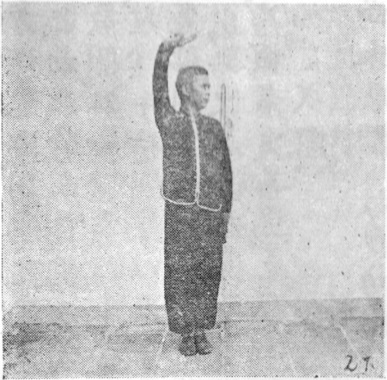
再將左脚踏前成左跨虎步,勢雖向前作移動,但其理想對敵者,則仍以左西方作目標之故,如『定式圗』。
Then your left foot steps forward to make a left sitting-tiger stance. Although the posture is shifting forward, your focus is still on the opponent, and so your gaze is still toward the west to your left. See photo 2b:
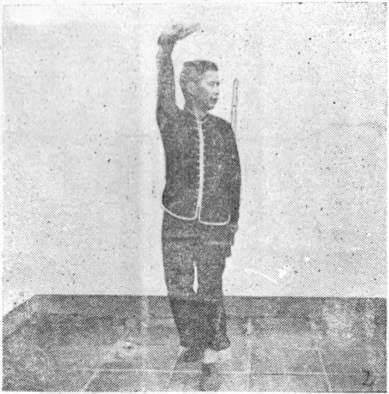
功用
Application:
劍雖未换手作刺擊劈殺之用,但劍訣乃練劍者必經之階段,㪽謂未練劍先練訣必修之課。
Although the sword has not yet switched hands to do any stabbing or chopping, the swordsman’s hex still has to be practiced. It is said: “To train with the sword, you must first train your swordsman’s hex.”
第三式 夜义探海式
Posture 3: NIGHT DEMON SEARCHES THE SEA
説明:
Explanation:
循上式,先拍前右後脚如第二過渡式圗状,然後提左脚作獨立式,左手劍斜斜提起與右手相接近,如『過渡式甲圗』。
Continuing from the previous posture, first your right foot stomps forward, then your left foot lifts to make a one-legged stance as your left hand lifts diagonally to bring the sword close to your right hand. See photo 3a:
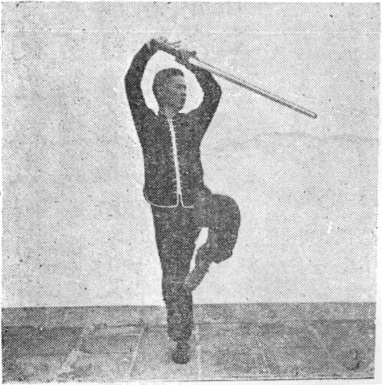
再由左手交劍過右手,右手接劍即向西前方自上插下,左脚亦隨劍而下,左手變成劍訣托於右腕之下,『如定式𡇫』。
Then your left hand places the sword in your right hand, which takes hold of the sword and sends it forward to the west, poking downward from above, your left foot lowering along with the sword, your left hand forming the swordsman’s hex and propping up under your right wrist. See photo 3b:
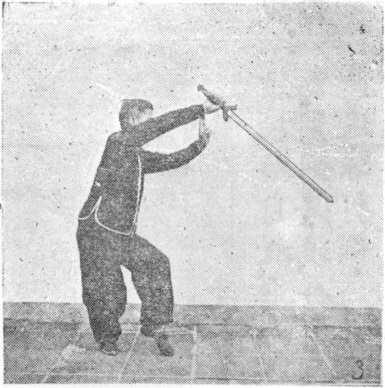
功用:
Application:
彼以刀劍短械之類向我胸腹之間刺來,我迅速運劍刺其持械之腕,使彼不淂不收械,斯為攻其㪽必救之着也。
An opponent uses a short weapon such as a saber or sword to stab to the area between my chest and belly, so I quickly send my sword stabbing to the wrist of the hand holding his weapon, causing him to have to withdraw it. This is a technique of attacking him in an area that he has to protect.
第四式 青龍坐窩式
Posture 4: BLUE DRAGON SITS IN ITS LAIR
説明:
Explanation:
循上式步向左扭去,劍由前隨步轉過左後方,如『過渡式甲圗』
Continuing from the previous posture, your feet twist to the left, the sword going along with your feet by arcing leftward to the rear. See photo 4a:
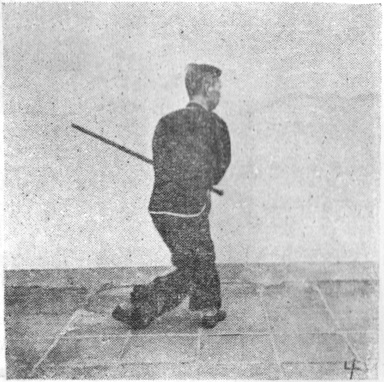
再由右脚自後進過西方,又以左脚自後偷入而成坐盤步,劍由後繞半圈形,然後平刺西前方,左劍訣斜攔頭上,如『定式圗』
Then your right foot advances to the west and your left foot does a stealth step behind it to make a sitting-twisted stance as the sword arcs a half circle from the rear and then does a level stab forward to the west, your swordsman’s hex blocking diagonally above your head. See photo 4b:
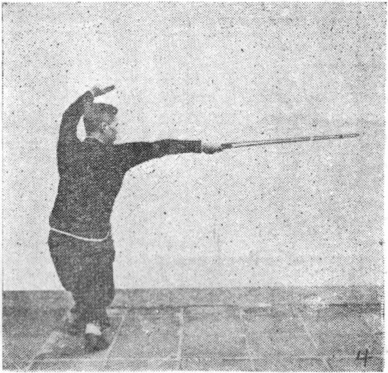
功用:
Application:
彼械擬自我下路攻來,我即用劍纒繞,再乘其撤退時追踪刺之。
The opponent’s weapon tries to attack my lower area, so I do a coiling action with my sword to send it away, then go along with his subsequent retreat by chasing him and stabbing.
第五式 白蛇吐信式
Posture 5: WHITE SNAKE FLICKS OUT ITS TONGUE
説明
Explanation:
循上式,左脚離地全身向右一𢴕以轉過東方,仍為坐盤,劍往內一收,左劍訣則貼於把後,如抱月之勢,如『過渡式甲圗』
Continuing from the previous posture, your left foot comes off the ground, your whole body twists around in a rightward turn toward the east, and you again make a sitting-twisted stance, the sword at the same time withdrawing and your swordsman’s hex touching the pommel, making a posture of “embracing the moon”. See photo 5a:
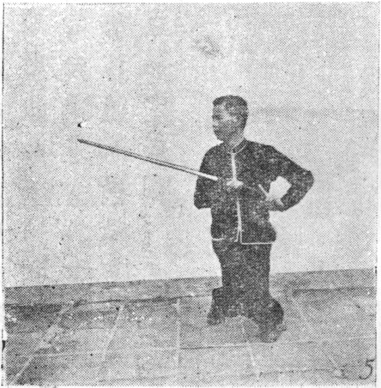
再全身往上一提,右脚獨立,右劍向上平刺,左訣橫攔於上,如『定式圗』
Then your whole body lifts up and your right leg stands one-legged as the sword goes upward into a level stab, your swordsman’s hex blocking across above you. See photo 5b:

功用
Application:
彼欲由我後襲擊,我亦循其勢而轉身,先以抱月法近之,再平刺而襲其上路。
An opponent behind me tries to make a surprise attack, so I turn around and first use an “embrace the moon” pose to bring him closer, then surprise him with a level stab to his upper area.
第六式 螳螂捕蝉式
Posture 6: MANTIS CATCHES A CICADA
説明
Explanation:
循上式,先將左脚落地,再提右脚,劍與訣俱向本身緊收,如『過渡式甲圗』。
Continuing from the previous posture, first your left foot comes down and then your right foot lifts, with both sword and swordsman’s hex coming in close to your body. See photo 6a:
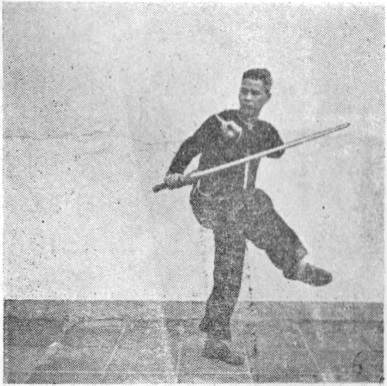
由提脚之勢疾跳過左方扑下而成扑腿勢,劍亦隨扑腿而橫撇過後方,訣則橫架頭上,如『定式圗』。
Quickly hop back toward your left side and crouch down to make a reaching-leg stance, the sword going along with the reaching leg by swinging across toward your rear, your swordsman’s hex propping up sideways above your head. See photo 6b:
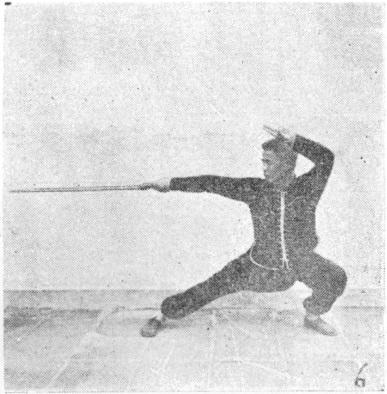
功用
Application:
彼低馬躱過我上式之髙刺,而復向我下路攻来,我小跳返身並用低撇法,破去来械。
The opponent lowers his stance to evade my high stab and then attacks to my lower area, so I do a small hop to retreat my body and do a low swinging technique to knock his weapon aside.
第七式 登山提劍式
Posture 7: MOUNTAIN-CLIMBING STANCE, LIFTING THE SWORD
説明
Explanation:
循上式,由右扑腿原步轉過東方成右登山步,劍由下反上,乘轉步之便状劍拖前,左劔訣倚於右腕內以助拖劍之勢,劍成平置,而劍鋒則略低斜,如『定式圗』。
Continuing from the previous posture, with your feet staying in their location, move to the east, switching to a right mountain-climbing stance, the sword at the same time turning over, going upward from below, and pulling forward, your swordsman’s hex touching to the inside of your right wrist to assist the pulling action. The sword body is almost level, the tip angled slightly lower. See photo 7:
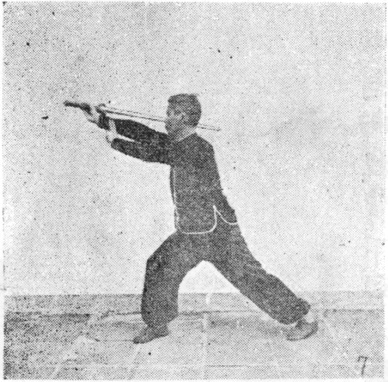
功用
Application:
来械旣為我上式撇去,彼再抽械反擊我上路,我以扑腿轉為登山步之時,即全身略一標前,以求與彼接近連用提劍法漏消之,来械極為兇猛亦莫能與我害也。
After I knock the opponent’s weapon aside in the previous technique, he then withdraws his weapon and counterattacks to my upper area, so I switch from the reaching-leg stance to a mountain-climbing stance, my whole body slightly dashing forward in order to crowd him while using a lifting technique to dispel his attack. Even if his attack is fierce, there is thus no way that he can harm me.
第八式 提腿刺劍式
Posture 8: LIFTING LEG, STABBING SWORD
説明
Explanation:
循上式,提右脚成獨立式,劍則陰手往肩後拖返,左訣倚貼右腕內,如『過渡式甲圗』。
Continuing from the previous posture, your right leg lifts to make a one-legged stance as the sword pulls back behind your right shoulder, the center of your right hand facing outward, your swordsman’s hex touching to the inside of your right wrist. See photo 8a:
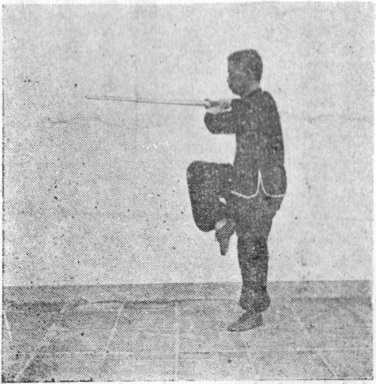
再落下右脚向前標去,而成登山式,劍隨步前直揷,左訣向上起,如『定式圗』。
Then your right foot comes down dashing forward to make a mountain-climbing stance, the sword going along with the step by poking forward, your swordsman’s hex lifting up. See photo 8b:
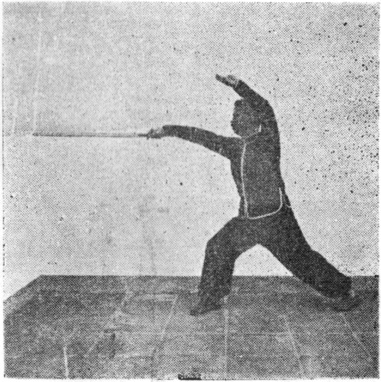
功用
Application:
彼以劍向我脅下刺来,我提步趁其来勢反以陰手盖去其劍,我旣盖消来械,即再順步標前刺之。
The opponent uses his sword to stab below my ribs, so I lift my leg and go along with his attack by turning my right hand over to seal off his sword. Once I have dispelled his attack, I then dash forward and stab at him.
第九式 登山提劍式
Posture 9: MOUNTAIN-CLIMBING STANCE, LIFTING THE SWORD
説明
Explanation:
循上式,進左脚成左登山式,劍由陰手復轉為陽手,再向前斜拖而出,左劍訣緊貼右腕之內,反劍與進步之時間上,必須力求吻合方能發生美妙之姿勢,否則便有呆滯之弊矣,如『定式圗』。
Continuing from the previous posture, your left foot advances to make a left mountain-climbing stance as the sword pulls diagonally forward, the center of your right hand switching from facing downward to facing inward, your swordsman’s hex touching to the inside of your right wrist. The key to the posture is that the sword turning over and the step advancing have to be done in unison or the posture will be performed too sluggishly. See photo 9:
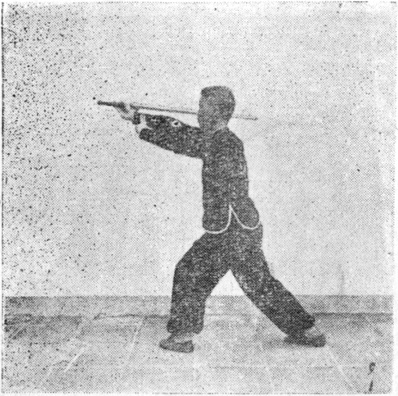
功用
Application:
劍法之運用,雖與第七式相同,惟標步與進步之時間有别,距離之逺近亦於劍術上有莫大之相連也。
Same as in Posture 7, except in this case stepping forward instead of simply moving forward into the stance. Getting the distance right is of the utmost importance in the sword art.
第十式 提腿刺劍式
Posture 10: LIFTING LEG, STABBING SWORD
説明
Explanation:
循上式,提右脚成獨立式,劍則陰手往肩後拖返,左訣倚貼右腕內,如『過渡式甲圗』。
Continuing from the previous posture, your right foot lifts to make a one-legged stance as the sword pulls back behind your right shoulder, the center of your right hand facing outward, your swordsman’s hex touching to the inside of your right wrist. See photo 10a:
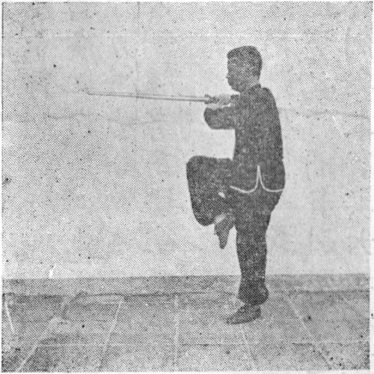
再落下右脚向前標去,而成登山式,劍隨步前直揷,左訣向上起,如『定式圗』。
Then your right foot comes down dashing forward to make a mountain-climbing stance, the sword going along with the step by poking forward, your swordsman’s hex lifting up. See photo 10b:
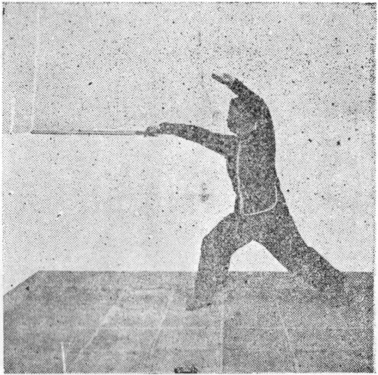
功用
Application:
彼以劍向我脅下刺来,我提步趁其来勢反以陰手盖去其劍,我旣盖消来械,即再順步標前刺之。
The opponent uses his sword to stab below my ribs, so I lift my leg and go along with his attack by turning my hand over to seal off his sword. Once I have dispelled his attack, I then dash forward and stab at him.
第十一式 鳳凰初蹶尾
Posture 11: PHOENIX DROPS ITS TAIL – FIRST TIME
説明
Explanation:
循上式,右前脚自面前轉移過左後方,劍由下往上成髙舉之勢,訣貼於右腕內,如『過渡式甲圗』。
Continuing from the previous posture, your right foot arcs across to the left rear as your sword goes upward from below to make a posture of being raised high, your swordsman’s hex touching to the inside of your right wrist. See photo 11a:

再移開左脚,右脚略拉後而成右跨虎式,劍繞成半圈形,然後陰手反挑而上,如『定式圗』。
Then your left foot steps out and your right foot slightly pulls back to make a right sitting-tiger stance as the sword arcs, drawing a half circle, and turns over to carry upward, the center of your right hand facing outward. See photo 11b:
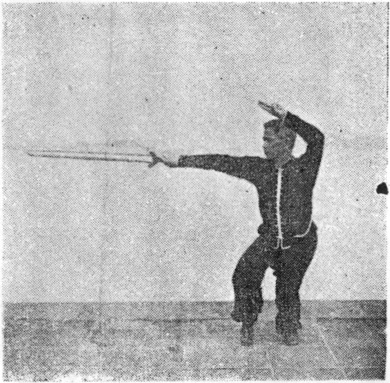
功用
Application:
彼械擬自我上擊来,我乃退馬避之,再由陰手反劍逆挑其腕下,第十二式,第十三式,與此式為相連作用。
The opponent’s weapon tries to strike me from above, so I retreat my stance to evade it, then turn over my sword to do a carrying cut under his wrist. This technique is performed three times as a continuous flow through Postures 11–13.
第十二式 鳳凰再蹶尾
Posture 12: PHOENIX DROPS ITS TAIL – SECOND TIME
説明
Explanation:
循上式,右前脚自面前轉移過左後方,劍由下往上成髙舉之勢,訣貼於右腕內,如『過渡式甲圗』。
Continuing from the previous posture, your right foot arcs across to the left rear as your sword goes upward from below to make a posture of being raised high, your swordsman’s hex touching to the inside of your right wrist. See photo 12a:
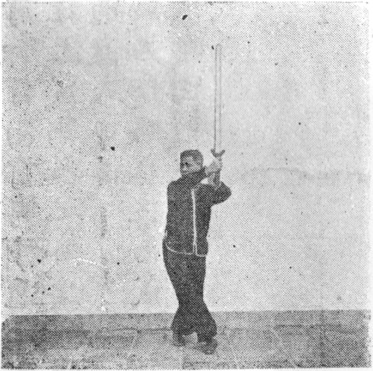
再移開左脚,右脚略拉後而成右跨虎式,劍繞成半圈形,然後陰手反挑而上,如『定式圗』。
Then your left foot steps out and your right foot slightly pulls back to make a right sitting-tiger stance as the sword arcs, drawing a half circle, and turns over to carry upward, the center of your right hand facing outward. See photo 12b:
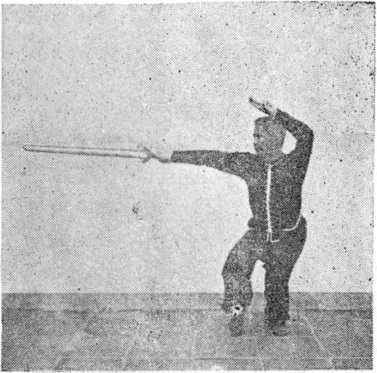
功用
Application:
彼械擬自我上擊来,我乃退馬避之,再由陰手反劍逆挑其腕下,第十二式,第十三式,與此式為相連作用。
The opponent’s weapon tries to strike me from above, so I retreat my stance to evade it, then turn over my sword to do a carrying cut under his wrist. This technique is performed three times as a continuous flow through Postures 11–13.
第十三式 鳳凰三蹶尾
Posture 13: PHOENIX DROPS ITS TAIL – THIRD TIME
説明
Explanation:
循上式右前脚自面前轉移過左後方,劍由下往上成髙舉之勢,訣貼於右腕內,如『過渡式甲圗』。
Continuing from the previous posture, your right foot arcs across to the left rear as your sword goes upward from below to make a posture of being raised high, your swordsman’s hex touching to the inside of your right wrist. See photo 13a:

再移開左脚,右脚略拉後而成右跨虎式,劍繞成半圈形,然後陰手反挑而上,如『定式圗』。
Then your left foot steps out and your right foot slightly pulls back to make a right sitting-tiger stance as the sword arcs, drawing a half circle, and turns over to carry upward, the center of your right hand facing outward. See photo 13b:
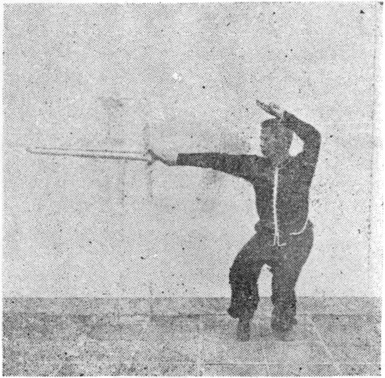
功用
Application:
彼械擬自我上擊来,我乃退馬避之,再由陰手反劍逆挑其腕下,第十二式,第十三式,與此式為相連作用。
The opponent’s weapon tries to strike me from above, so I retreat my stance to evade it, then turn over my sword to do a carrying cut under his wrist. This technique is performed three times as a continuous flow through Postures 11–13.
第十四式 青龍坐窩式
Posture 14: BLUE DRAGON SITS IN ITS LAIR
説明
Explanation:
循上式,全身向右一𢴕,而成坐盤之勢,劍則平收於胸腹之間,為懷中抱月之勢,劍平收,訣頂緊劍把之末端,以助其勢,如『定式圗』。
Continuing from the previous posture, your whole body twists to the right to make a sitting-twisted stance as the sword withdraws between your chest and belly to make a posture of “embracing the moon”, your swordsman’s hex touching the pommel to assist the posture. See photo 14:

功用
Application:
此坐窩勢,不但全身易勢,且劍在收放之間,亦有其妙用存乎其間,斯亦蓄勢待發之奇着,若非有下式之展開,則其長處寔未易窺其堂奧。
This posture of “sitting in the lair” is not just a matter of changing the position of the whole body. The key to it lies in the moment of withdrawing the sword and releasing it. This is a technique of storing power and waiting to express it. Without the action of spreading open in the following posture, it would not be easy to see the profound value of this one.
第十五式 喜雀躍登枝
Posture 15: HAPPY SPARROW HOPS ONTO A BRANCH
説明
Explanation:
循上式,先提起左脚,而成獨立之勢,再將劍斜向後方斜舉,如『過渡式甲圗』。
Continuing from the previous posture, your left foot lifts to make a one-legged stance as the sword rises and goes diagonally to the rear. See photo 15a:
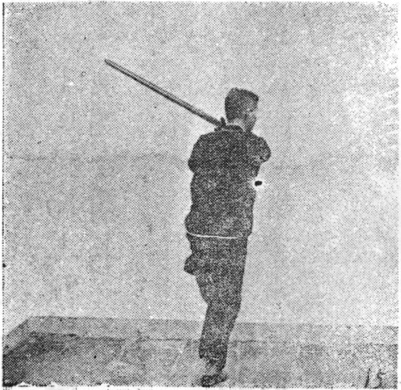
再全身躍起,右脚與劍向右方,齊出劍為陰手,平劍直標而出,如『定式圗』。
Then your whole body jumps up, the sword and your right foot going out to the right in unison, the center of your right hand facing outward, the sword rushing out until level. See photo 15b:
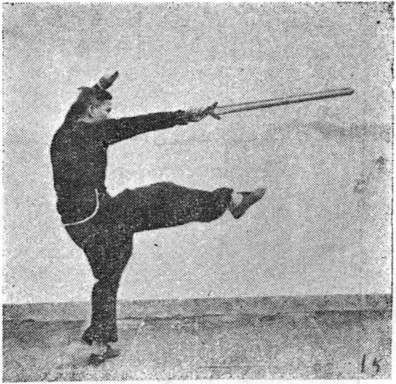
功用
Application:
此式既能以脚與劍齊攻對方之中上路,又可藉劍擊去對方之械,而以脚攻彼之中下路也。
With this posture, I can use my sword to attack the opponent’s upper area and my foot to attack his middle area at the same time, or I could use my sword to strike away his weapon and use my foot to attack his middle or lower area.
第十六式 鳳凰坐窩式
Posture 16: PHOENIX SITS IN ITS NEST
説明
Explanation:
循上式,先落右脚,再由左脚向後偷進而成坐盤之勢,劍自前往後轉一大弧形,然復由下反挑而上,訣則隨劍轉而轉,再復橫攔於頭上。如『定式圗』
Continuing from the previous posture, first your right foot comes down and then your left foot does a stealth step behind it to make a sitting-twisted stance, the sword drawing a large arc from the front to the rear and then carrying upward from below, your swordsman’s hex going along with the arcing of the sword and then blocking across above your head. See photo 16:
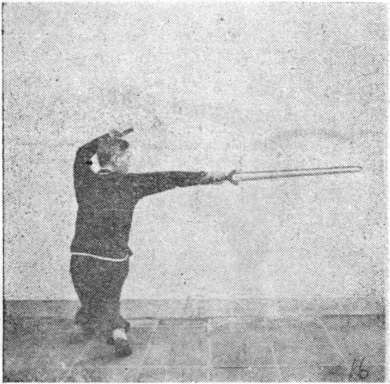
功用
Application:
彼欲卸步躱避我登枝之勢,我則緊廹其退之弱點,更進前反劍倒挑之。
The opponent tries to withdraw a step to evade my “hop onto a branch” technique, so I crowd into the weak spot of his retreat, advancing while turning my sword over to do a reverse carrying action.
第十七式 金龍大盤柱
Posture 17: GOLDEN DRAGON COILS AROUND THE PILLAR
説明
Explanation:
循上式,先将左脚向左開出,而成左登山式,劍由面前繞過左臂之外,如『過渡式甲圗』。
Continuing from the previous posture, first your left foot steps out to the left to make a left mountain-climbing stance as the sword arcs across toward the outside of your left arm. See photo 17a:
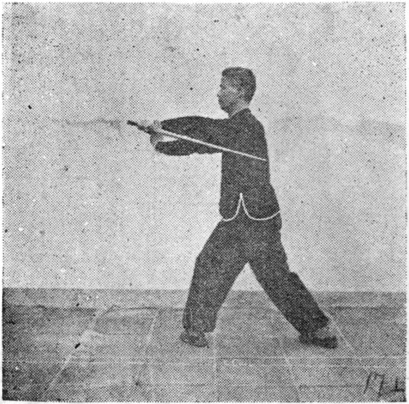
再原劍不動,進右脚而成右登山式,如『過渡式乙圗』。
While maintaining the sword position, your right foot then advances to make a right mountain-climbing stance. See photo 17b:

再以左脚自後退成轉身勢之右登山式,劍仍緊貼於左臂外,如『定式圗』。
Then your left foot retreats a step behind you as you turn your body around to make another right mountain-climbing stance, the sword still close to the outside of your left arm. See photo 17c:

功用
Application:
此式乃連續退却几四步,除三圗外,應再加如乙圗為合,其妙處在乎退却與追擊之間,多練可使身手步俱靈活異常也。
This posture is a continuous retreat for about four steps, and so beyond these three photos, there probably ought to be an additional one, a 17d that would be similar to 17b. The key to this technique is the moment between retreat and chase [when continuing into the following posture]. Frequent practice of this posture can bring an unusual nimbleness to your body, hands, and steps.
第十八式 鳳凰點頭式
Posture 18: PHOENIX NODS ITS HEAD
説明
Explanation:
循上乙圗,提左脚而成獨立式,劍自左下方轉而由上向前劈落,至手與劍俱直為止,左訣橫攔頭上,如『定式圗』。
Continuing from the previous posture, your left foot lifts to make a one-legged stance as the sword arcs upward from the left and chops down forward until your right arm and the sword are both making a straight line, your swordsman’s hex blocking across above your head. See photo 18:
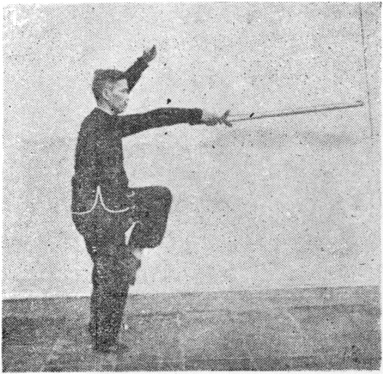
功用
Application:
我上式,劍隨身轉,使彼無懈可擊,退固淂宜也,然彼方欲退時,我亦可用此㳒追擊之,至形勢予我有利時,則轉為點劈之勢,使彼上路受我迎頭劈落,而有莫大之威脅。
In the previous technique, my sword followed along with the turning of my body causing the opponent to have no place to attack while I retreat to a better position. But then once he himself decides to retreat, I can use this technique to chase him. Since the situation has now given the advantage to me, I switch to doing a tapping chop. When his upper area is being subjected to my chop coming straight down at him, he is in the utmost peril.
第十九式 老僧入定式
Posture 19: MONK GOES INTO A TRANCE
説明
Explanation:
循上式,先將提起之左脚退後一步,再退右脚一步,而成正面坐盤之勢,劍平置,劍把向腹部,劍鋒端微蹺起至本人頭部眉齊,左訣緊貼把之末端,如『定式圗』。
Continuing from the previous posture, first your left foot retreats a step, then your right foot, making a sitting-twisted stance, as the sword handle withdraws toward your belly, the tip slightly raising until at eyebrow height, your swordsman’s hex touching the pommel. See photo 19:

功用
Application:
彼坐馬躱過我上劈之劍,隨即由我中下路擊来,我乃連退兩步以隔開其距離,再以劍向內收,使彼械無門可進也。
The opponent evades my chopping action and then attacks my middle or lower area, so I retreat two steps to get away from him as my sword withdraws to keep him from being able to get to me.
第二十式 和尚撞金鐘
Posture 20: MONK RINGS THE GOLDEN BELL
説明
Explanation:
循上式,先起右脚,使全身騰空而轉為右獨立式,劍平放直出,訣向上揚起,兩動作須同時間而成,否則便呆滯不堪矣,練此式時希為注意,如『定式圗』。
Continuing from the previous posture, first your right foot lifts, then your body hops up [with your left foot lifting] to switch to a right one-legged stance, as the sword shoots out level and your swordsman’s hex rises up. Both of these actions [the movement of the lower body and the movement of the upper body] have to be carried out simultaneously or the posture will be performed too sluggishly. When practicing this posture, I hope you will pay attention to this point. See photo 20:

功用
Application:
上式乃收閉,此式則為放蹤,互相呼應,如同表裡,則相淂益彰,若單獨一式,則俱有未完善之處,收放髙低,足見二式各擅之勝。
The previous posture withdraws and this posture shoots out, both postures working together, an inward and an outward, both parts fulfilled by being accompanied by the other part. If they are performed only as separate techniques, they would be incomplete. Withdrawing and releasing, moving low and then high, the distinct strengths of both postures are revealed in relation to each other.
第二十一式 鷂子大翻身
Posture 21: HAWK TURNS OVER
説明
Explanation:
循上式,先落左脚過後方成跨虎式,劍自前斜過後下方,如『過渡式甲圗』。
Continuing from the previous posture, first your left foot comes down to the rear to make a sitting-tiger stance as the sword goes diagonally downward to the rear. See photo 21a:
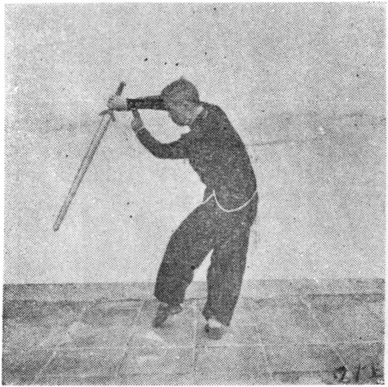
再進右脚退左脚,而成類似之登山式,劍向後斜舉,如『過渡式乙圗』。
Then your right foot advances and your left foot retreats to make a half mountain-climbing stance as the sword raises diagonally toward the rear. See photo 21b:

再後移正原步成右登山式,劍自後往前逆劏而上,如『定式圗』。
Then shift further to the rear in the same position to make a full right mountain-climbing stance as the sword goes forward and upward with a reverse slashing cut. See photo 21c:
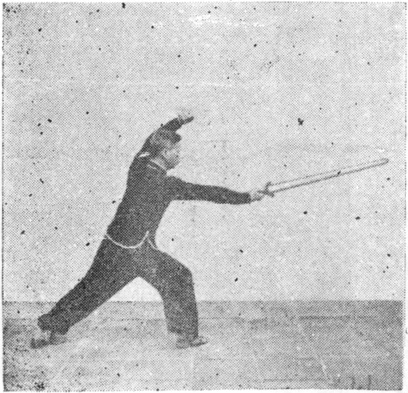
功用
Application:
彼欲自我後方擊入,我轉身迎擊之,彼又欲轉身躱避,我亦隨而轉身逆劏其襠下焉。
An opponent tries to attack me from behind, so I turn around to meet it, but he also turns his body to evade my weapon, so I go along with his turn and do a reverse slashing cut to his crotch.
第二十二式 呂洞賓斬蛇
Posture 22: LÜ DONGBIN BEHEADS THE SNAKE
説明
Explanation:
循上式,先退右脚,劍隨步往後退,訣貼於右肩之內,如『過渡式甲圗』。
Continuing from the previous posture, first your right foot retreats, the sword going to the rear along with your step, your swordsman’s hex going close to the inside of your right shoulder. See photo 22a:

再全身往左方一扭,成坐盤之勢,劍由後往前直劈而下,左訣貼於右腕內,如『定式圗』。
Then your whole body twists to the left to make a sitting-twisted stance as the sword goes forward from the rear and chops straight down, your swordsman’s hex touching to the inside of your right wrist. See photo 22b:

功用
Application:
彼擬以械刺擊我膝部,我退步以劍撇去之,再扭身劈其来械,使彼失去優势作用,於是我乃佔盡上風矣。
The opponent tries to use his weapon to stab to my knee, so I retreat while using my sword to swing it away, then twist my body and chop to his weapon, causing him to lose his advantage and placing myself in the superior position.
第二十三式 蘇秦佩寳劍
Posture 23: SU QIN WEARS HIS PRECIOUS SWORD
説明
Explanation:
循上式,就原地提右脚成左獨立式,劍隨步而提起,成斜佩势,左訣緊貼右肘之內,如『定式圗』。
Continuing from the previous posture, staying where you are, your right foot lifts to make a left one-legged stance, the sword lifting along with your leg to make a pose of diagonally wearing the sword [i.e. on the back], your swordsman’s hex touching to the inside of your right elbow. See photo 23:
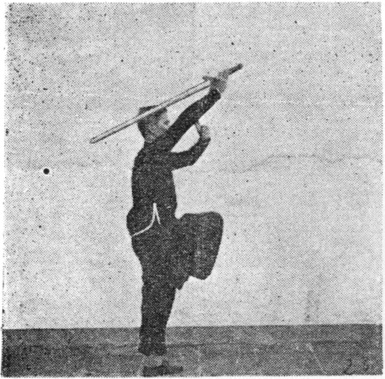
功用
Application:
右佩劍法,是連把斜掛背後者,為文劍,如蘇秦,張良,等,文人之㪽佩帶者,武士上陣,則將劍懸佩於腰部,是為掛劍,此式是將来械挑去之法。
This action of “wearing the sword” on the right side would continue into hanging it diagonally behind your back. It is an example of the “civil sword”, worn in the manner of scholars such as Su Qin and Zhang Liang. For warriors going into battle, the sword would be hung at the waist, but this is a posture of the sword hanging [as in the drawings at the beginning of the book]. This technique is a method of carrying away an incoming weapon.
第二十四式 鳳凰初點頭
Posture 24: PHOENIX NODS ITS HEAD – FIRST TIME
説明
Explanation:
循上式,右脚踏前,劍由上斜落於後提起左脚,訣收右肩內,如『過渡式甲圗』。
Continuing from the previous posture, your right foot comes down forward as the sword lowers diagonally from above until behind you, your left foot lifting, your swordsman’s hex going to the inside of your right shoulder. See photo 24a:

然後全身蹤跳步躍前成右登山之勢,劍由下反上,復向前劈去,訣繞於上,如『定式圗』。
Then your whole body jumps forward to make a right mountain-climbing stance as the sword goes upward from below and then chops forward, your swordsman’s hex arcing to be above you. See photo 24b:

功用
Application:
彼械既為我劍挑去,彼乃轉向我下方刺来,我先以下攔之法消去之,再利用蹤跳躍進追擊法,直劈彼之頭部。
Once the opponent’s weapon has been carried aside by my sword, he then switches to stabbing me below, so I first block downward to dispel his attack, then take advantage of the opportunity by leaping forward to chase him and chop to his head.
第二十五式 鳳凰再點頭
Posture 25: PHOENIX NODS ITS HEAD – SECOND TIME
説明
Explanation:
循上式,右脚踏前,劍由上斜落於後提起左脚,訣收右肩內,如『過渡式甲圗』。
Continuing from the previous posture, your right foot comes down forward as the sword lowers diagonally from above until behind you, your left foot lifting, your swordsman’s hex going to the inside of your right shoulder. See photo 25a:
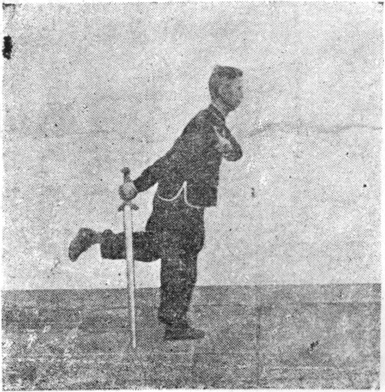
然後全身蹤跳步躍前成右登山之勢,劍由下反上,復向前劈去,訣繞於上,如『定式圗』。
Then your whole body jumps forward to make a right mountain-climbing stance as the sword goes upward from below and then chops forward, your swordsman’s hex arcing to be above you. See photo 25b:
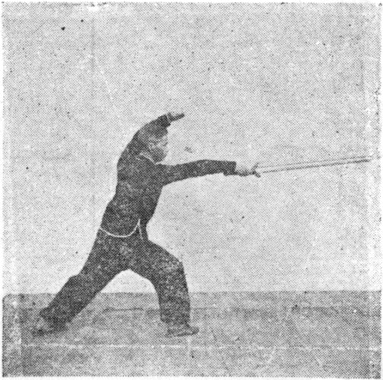
功用
Application:
彼械既為我劍挑去,彼乃轉向我下方刺来,我先以下攔之法消去之,再利用蹤跳躍進追擊法,直劈彼之頭部。
Once the opponent’s weapon has been carried aside by my sword, he then switches to stabbing me below, so I first block downward to dispel his attack, then take advantage of the opportunity by leaping forward to chase him and chop to his head.
第二十六式 鳳凰三點頭
Posture 26: PHOENIX NODS ITS HEAD – THIRD TIME
説明
Explanation:
循上式,右脚踏前,劍由上斜落於後,提起左脚,訣收右肩內,如『過渡式甲圗』。
Continuing from the previous posture, your right foot comes down forward as the sword lowers diagonally from above until behind you, your left foot lifting, your swordsman’s hex going to the inside of your right shoulder. See photo 26a:

然後全身蹤跳步躍前成右登山之勢,劍由下反上,復向前劈去,訣繞於上,如『定式圗』。
Then your whole body jumps forward to make a right mountain-climbing stance as the sword goes upward from below and then chops forward, your swordsman’s hex arcing to be above you. See photo 26b:
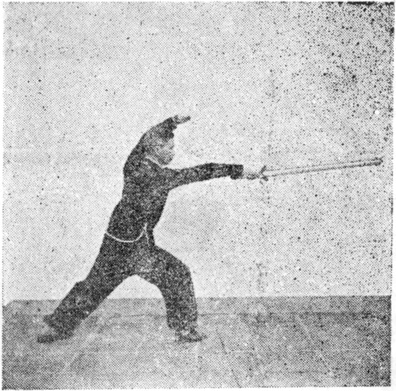
功用
Application:
彼械既為我劍挑去,彼乃轉向我下方刺来,我先以下攔之法消去之,再利用蹤跳躍進追擊法,直劈彼之頭部。
Once the opponent’s weapon has been carried aside by my sword, he then switches to stabbing me below, so I first block downward to dispel his attack, then take advantage of the opportunity by leaping forward to chase him and chop to his head.
第二十七式 金鈎掛玉瓶
Posture 27: THE JADE VASE HANGS FROM THE GOLDEN HOOK
説明
Explanation:
循上式,右脚先往後退,而成右登山式,劍隨退步而轉向下,如『過渡式甲𡇫』。
Continuing from the previous posture, first your right foot retreats [your body turning rightward] to make a right mountain-climbing stance, the sword going along with the retreat by arcing downward. See photo 27a:
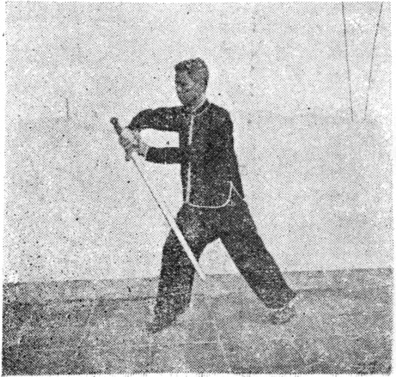
再進左脚成跨虎步,劍向下斜势攔起,訣倚右腕內,如『定式𡇫』。
Then your left foot advances to make a sitting-tiger stance as the sword rises to block with the sword body angled downward, your swordsman’s hex shifting to the inside of your right wrist. See photo 27b:
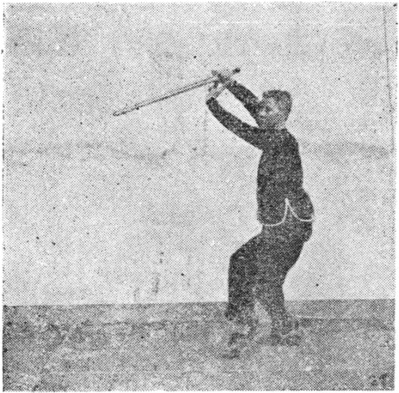
功用
Application:
彼械擬自我後劈来,我即轉身斜攔之。
An opponent’s weapon tries to chop at me from behind, so I turn around and diagonally block it.
第二十八式 斜步倒掛劍
Posture 28: DIAGONAL STEP, REVERSE HANGING
説明
Explanation:
循上式,左脚向左移開,成斜登山之勢,右手劍向右沉手挑劍,如『過渡式甲圗』。
Continuing from the previous posture, your left foot steps out to the left to make a diagonal mountain-climbing stance as your right hand sends the sword to the right, the hand sinking to carry the sword. See photo 28a:
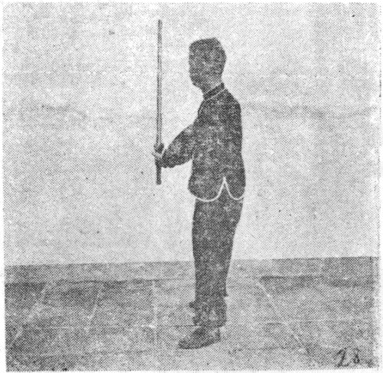
再進右脚,而成右跨虎步,劍自下,斜起如『定式圗』。
Then your right foot advances to make a right sitting-tiger stance as the sword lifts diagonally from below. See photo 28b:
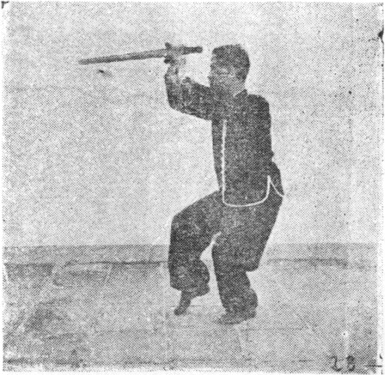
功用
Application:
彼不淂志我之右方,乃欲改向我左方攻来,我乃漏劍斜托之。
The opponent cannot get to my right side, so he switches to attacking my left side, and I then withdraw my sword, propping up diagonally.
第二十九式 走步斜刺劍
Posture 29: WALKING AWAY, STABBING DIAGONALLY
説明
Explanation:
循上式,先将右脚向右移開,成登山勢,劍隨步向下沉低,如『過渡式甲𡇫』。
Continuing from the previous posture, first your right foot shifts out to the right to make a mountain-climbing stance, the sword going along with the step by sinking down. See photo 29a:
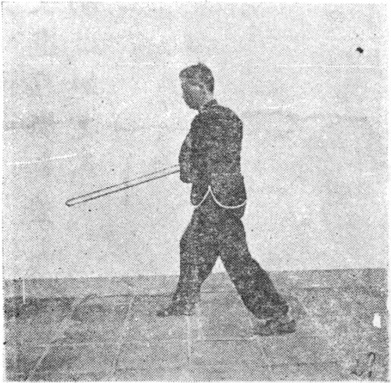
再将左脚向後斜開,即合两步便成登山势,劍向斜方刺出,如『定式𡇫』。
Then your left foot steps diagonally behind you and you add two more such steps [right then left] to make another mountain-climbing stance, the sword stabbing out diagonally. See photo 29b:
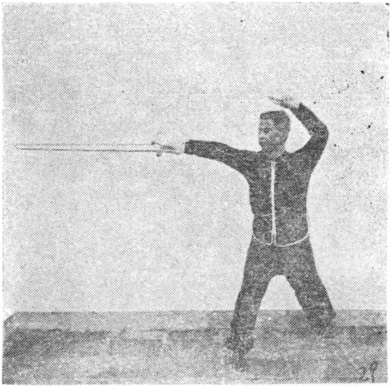
功用
Application:
我既两招来械,尚未予以還擊,但此勢則斜走登山刺之。
After blocking the opponent’s weapon twice without a good opportunity to counterattack, in this posture I finally step diagonally into a mountain-climbing stance and stab at him.
第三十式 左走反刺劍
Posture 30: WALKING TO THE LEFT, COUNTERING WITH A STAB
説明
Explanation:
循上式,先進左脚,成登山式,劍往下沉,如『過渡式甲𡇫』。
Continuing from the previous posture, first your left foot advances to make a mountain-climbing stance as the sword sinks down. See photo 30a:

再進右脚,又進左脚,成登山步,劍向正面直刺而出,如『定式𡇫』。
Then your right foot advances and your left foot advances again to make a mountain-climbing stance as the sword stabs out directly forward. See photo 30b:

功用
Application:
與上式乃成左右連環之勢,互相呼應,使彼窮於應付也。
Combined with the previous technique, this forms a continuous action of moving to each side, both techniques working together to cause the opponent to have no idea how to deal with what is happening.
第三十一式 圈劍劈華山
Posture 31: CIRCLING SWORD, CHOP TO MT. HUA
説明
Explanation:
循上式,先提右脚,成獨立式,劍隨步殺落,如『過渡式甲𡇫』。
Continuing from the previous posture, first your right foot lifts to make a one-legged stance, the sword at the same time smashing downward. See photo 31a:

再将提起之右脚,進正前方,成登山式,劍由下圈上,復劈於前,如『定式圗』。
Then your right foot goes forward to make a mountain-climbing stance as the sword circles from below and then chops forward. See photo 31b:

功用
Application:
彼漏下以械向我襠下刺来,我先提步削去之,更廹進力劈其上。
The opponent ducks down and uses his weapon to stab to my crotch, so I first lift my leg while cutting away his attack, then crowd in and do a powerful chop to his upper area.
第三十二式 螳螂捕蟬式
Posture 32: MANTIS CATCHES A CICADA
説明
Explanation:
循上式,先提起右脚,劍隨步往後斜撇而落,如『過渡式甲𡇫』。
Continuing from the previous posture, first your right foot lifts, the sword going along with this stance change by swinging across diagonally downward. See photo 32a:

再落右脚,成扑腿式,劔轉繞一圈,然後斜撇而下,如『定式𡇫』。
Then your right foot comes down to make a reaching-leg stance as the sword arcs through a full circle and swings diagonally downward. See photo 32b:
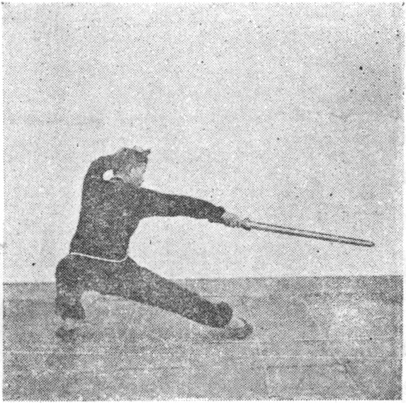
功用
Application:
彼擬自我後下路擊来,我即扑腿圈劈之。
An opponent behind me tries to attack my lower body, so I go into a reaching-leg stance while doing a circular chop.
第三十三式 跨虎挑寳劍
Posture 33: SITTING-TIGER STANCE, CARRYING A PRECIOUS SWORD
説明
Explanation:
循上式,拉起右脚,成右跨虎步,劔由下挑上,當挑起時,腕部旋轉而着力於劍尖,左訣貼於右內肘下如『定式𡇫』
Continuing from the previous posture, your right foot lifts and pulls back to make a right sitting-tiger stance as your sword carries upward from below, your wrist at the same time rotating to bring power to the sword tip, your swordsman’s hex lowering to the inside of your right elbow. See photo 33:
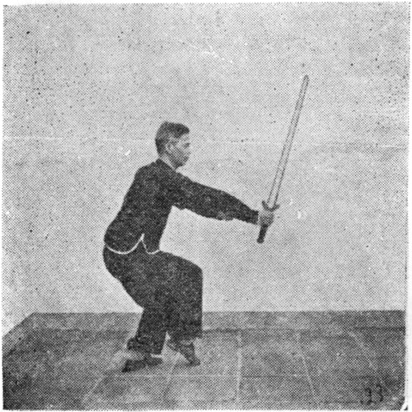
功用
Application:
彼以我用螳螂捕蟬之下盤劔法削彼前鋒馬,而彼謀還擊我在空虛中之上門,我以其勢速而收馬轉為虛式,劍端挑起,以破其劈刺之法。
When I use the previous technique to cut to the opponent’s front leg, he tries to counterattack to the gap at my upper area, so I quickly withdraw my front leg and switch to an empty stance, my sword tip carrying upward to defeat his chop or stab.
第三十四式 入環右橫劍
Posture 34: KNEELING STANCE, RIGHT SWINGING SWORD
説明
Explanation:
循上式,由右脚踏前,全身標進,轉成右入環步,劍由右方中平橫撇,隨步標入,如『定式圗』。
Continuing from the previous posture, your right foot steps forward and your whole body dashes forward [with your left foot also pulling forward] to make a right kneeling stance as the sword swings across from right to left. See photo 34:

功用
Application:
来械既被我上式挑劍法消去,我即循其空隙標馬逼近之,再以橫門中平劍橫撇彼腰部,使彼陷於進退失據之間,而為我㪽乘也。
Having used a carrying technique to send away the opponent’s incoming weapon, I then find a gap and dash forward to crowd into it while swinging my sword across to his waist, thereby putting him in a situation in which he can neither advance nor retreat, giving me the advantage.
第三十五式 入環左橫劍
Posture 35: KNEELING STANCE, LEFT SWINGING SWORD
説明
Explanation:
循上式,原步不動,向前再標仍成右入環步,劍由右轉撥左方,然後再橫劍向前平殺而出,如『定式圗』。
Continuing from the previous posture, with your feet maintaining their position, dash forward to again make a right kneeling stance as the sword makes a deflecting arc from right to left and then smashes forward with the sword body crosswise and level. See photo 35:
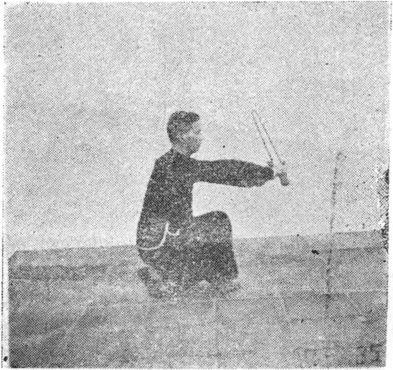
功用
Application:
彼以我用平劍橫撇其腰部,乃即退馬求躱避,我不俟其取淂反擊機會,而採取連環進攻方式,使彼自陷於絕地也。
When I swing my sword across to the opponent’s waist, he retreats to try to evade it. Instead of waiting for him to find a chance to counterattack, I continue right into doing another advancing attack, causing him to fall into a dangerous position.
第三十六式 上訣橫門劍
Posture 36: HEXING ABOVE WHILE SENDING THE SWORD ACROSS
説明
Explanation:
循上式,先進左脚,劍由左撥過右方,如『過渡式甲𡇫』。
Continuing from the previous posture, first your left foot advances as the sword deflects to your right side. See photo 36a:
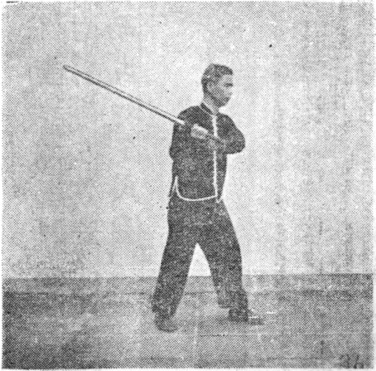
再全身標前,成左入環步,劍仍用中平劍橫撇於前,左訣則轉而在上,如『定式圗』。
Then your whole body dashes forward to make a left kneeling stance as the sword again swings across [from right to left] until in front of you, your swordsman’s hex arcing upward. See photo 36b:
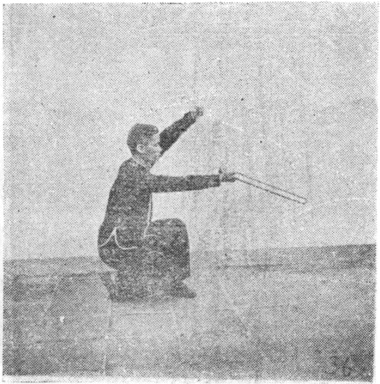
功用
Application:
定式雖与卅四式略同,但其轉勢易步之微妙處,則各有千秋。
Although the finished posture is almost the same as in Posture 34, switching stances in this case is more subtle. But both versions are worthy.
第三十七式 提腿刺劍式
Posture 37: LIFTING LEG, STABBING SWORD
説明
Explanation:
循上式,先提右脚成獨立式,劍往右後方平拉而起,如『過渡式甲𡇫』
Continuing from the previous posture, first your right foot lifts to make a one-legged stance as the sword pulls back to the right rear, lifting to be level. See photo 37a:

再落右脚成登山式,劍平刺而出,如『定式圗』。
Then your right foot comes down to make a mountain-climbing stance as the sword does a level stab. See photo 37b:

功用
Application:
彼械自我中上路擊進,我先用劍往後拖消之,再落步直刺彼之喉部。
The opponent’s weapon attacks to my middle or upper area, so I first dispel his attack by using my sword to pull to the rear, then step down and stab straight to his throat.
第三十八式 扭步劈華山
Posture 38: TWISTING STANCE, CHOP TO MT. HUA
説明
Explanation:
循上式,全身向右一轉而成為扭步式,劍隨步轉劈過後方,如『定式𡇫』。
Continuing from the previous posture, your whole body turns to the right [with your left foot pulling in] to make a twisting stance, the sword going along with the step and the turn by chopping to the rear. See photo 38:
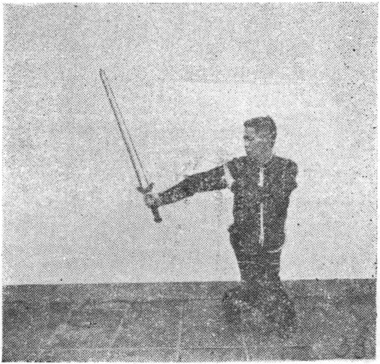
功用
Application:
彼突走過我後方,或另一敵人自我後擊来,於時間上並不許我有換步轉勢之機,因此我乃以最迅速之扭步法,轉身迎頭劈之。
The opponent suddenly dodges around behind me, or there is already another opponent attacking me from behind. In such a situation, I have no time to switch my feet to properly turn around, so I use the quickest means of just twisting my stance and turning my body in order to chop to his head.
第三十九式 跨虎單展翅
Posture 39: SITTING-TIGER STANCE, SPREADING A SINGLE WING
説明
Explanation:
循上式,先移開右脚,劍往右後方斜開,如『過渡式甲𡇫』。
Continuing from the previous posture, first your right foot steps out as the sword goes out diagonally to your right rear. See photo 39a:

再移正成右跨虎步,劍隨轉過左後方一圈,再陰手自下劏上,如『定式圗』。
Then shift fully into a right sitting-tiger stance as the sword draws a complete circle, arcing to the left rear and then going upward from below with a slashing cut, the center of your right hand facing outward. See photo 39b:
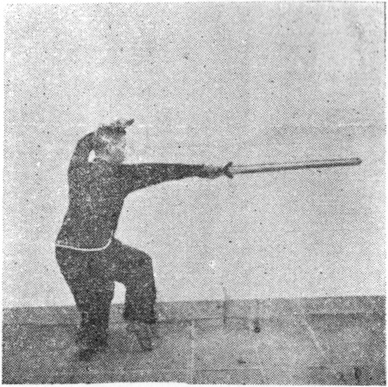
功用
Application:
彼人繞過背後偷襲我後方,我既而轉身反手劏之。
The opponent slips around behind me to try to make a surprise attack, so I turn around and slash at him with my right hand turned over.
第四十式 游龍大擺尾
Posture 40: SWIMMING DRAGON SWINGS ITS TAIL
説明
Explanation:
循上式,由右方轉過左成半登山步,劍斜繞過左下方,如『過渡式甲𡇫』。
Continuing from the previous posture, turn from right to left to make a half mountain-climbing stance as the sword arcs diagonally downward to your left side. See photo 40a:
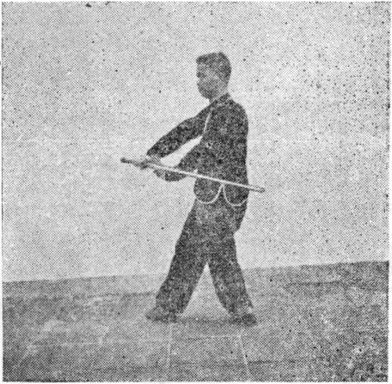
右脚進前成半扭步状,劍則自左方穿繞過右方,如『過渡式乙𡇫』。
Then your right foot advances to make a half twisting stance as the sword threads through in an arc from left to right. See photo 40b:
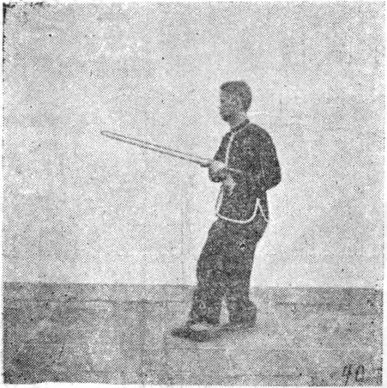
再進左脚成半扭步式,劍再穿繞左下斜方,如『定式圗』。
Then your left foot advances to make a half twisting stance, the sword again threading through in an arc that goes diagonally downward to your left. See photo 40c:

功用
Application:
此式乃左右穿閃之着,然非練之有素甚難有良好之成績。
This is a technique of making sudden threading attacks from side to side. You have to practice it to the point that it becomes second nature or it will be difficult to get good results from it.
(註);此式須連續以(甲),(乙),(定),等三式分(一),(二),(三),穿進方合,且進時,劍與身,手,步,互相吻合,為唱歌之拍節,方称上乘也。
(Note: This posture has to be done as a continuous action of photos 40a–40c, the three separate parts combined into a single threading advance. When advancing, the sword, body, hands, and steps have to be as coordinated as a musical rhythm, and only then can you be considered to be performing this technique at a high level.)
第四十一式 跨虎劈華山
Posture 41: SITTING-TIGER STANCE, CHOP TO MT. HUA
説明
Explanation:
循上式,先進前右脚成右跨虎步,劍自左下方轉向上往前直劈而下,左訣橫斜於頭上,如『定式𡇫』。
Continuing from the previous posture, your right foot advances to make a right sitting-tiger stance as the sword arcs upward, forward, and chops downward, your swordsman’s hex arcing until sideways over your head. See photo 41:

功用
Application:
我上式用纒繞法逼使對方不斷後退,我乃緊廹其屡退之弱點而迎頭劈下。
In the previous posture, I used a coiling technique to make the opponent keep retreating, and now I force my way into the gap of his retreating posture by chopping down at his head.
第四十二式 跨虎倒低挑
Posture 42: SITTING-TIGER STANCE, REVERSE CARRYING
説明
Explanation:
循上式,先提起左脚,劍收於左下方,如『過渡式甲𡇫』。
Continuing from the previous posture, first your left foot lifts as the sword withdraws downward to your left. See photo 42a:

再用小跳法向前躍進成跨虎步,劍自下反手倒挑而上至平為止如『定式𡇫』。
Then do a small hop forward to again make a sitting-tiger stance as the sword goes upward from below with a reverse carrying action until level. See photo 42b:
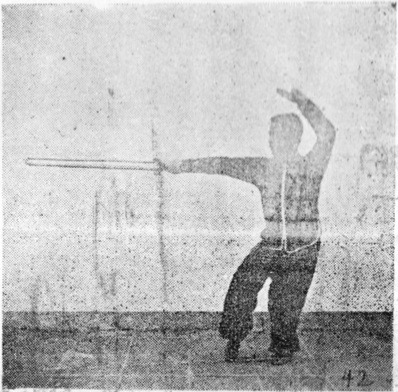
功用
Application:
我上式既用迎頭劈下法劈之,此式則改用倒挑法自下而上。
In the previous technique, I used a chopping action to the opponent’s head, but in this technique, I instead go upward from below with a reverse carrying action.
第四十三式 螳螂捕蟬式
Posture 43: MANTIS CATCHES A CICADA
説明
Explanation:
循上式,先提起右脚,劔隨步往後斜撇而落,如『過渡式甲𡇫』。
Continuing from the previous posture, first your right foot lifts, the sword going along with this stance change by swinging across diagonally downward. See photo 43a:
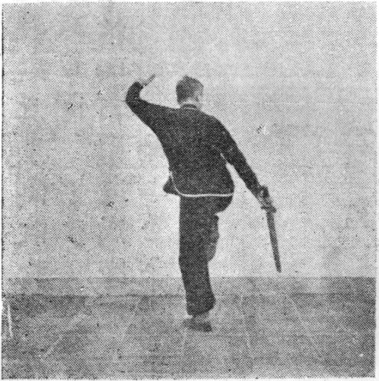
再落右脚,成扑腿式,劔轉繞一圈,然後斜撇而下,如『定式𡇫』。
Then your right foot comes down to make a reaching-leg stance as the sword arcs through a full circle and swings diagonally downward. See photo 43b:

功用
Application:
彼擬自我後下路擊来,我即扑腿圈劈之。
An opponent behind me tries to attack my lower body, so I go into a reaching-leg stance while doing a circular chop.
第四十四式 夜义探海式
Posture 44: NIGHT DEMON SEARCHES THE SEA
説明
Explanation:
循上式,先提起右脚成獨立式,劍往後撇去,如『過渡式甲𡇫』。
Continuing from the previous posture, first your right foot lifts to make a one-legged stance as the sword swings away to your rear. See photo 44a:
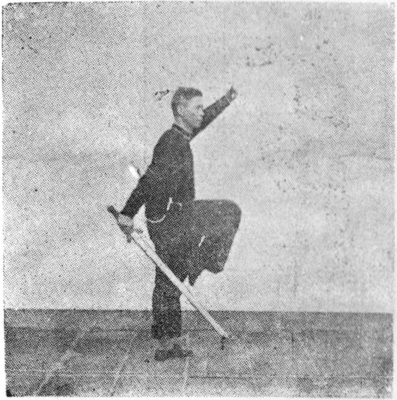
再落右脚進左脚成跨虎步,劍繞過後方斜斜插落,如『定式𡇫』
Then your right foot comes down and your left foot advances to make a sitting-tiger stance as the sword continues to arc through behind you and then pokes diagonally downward. See photo 44b:

功用
Application:
彼以刀劍之類短械向我胸腹之間刺来,我迅即運劍刺其持械之腕,使彼不淂不收械而廽避,斯為攻其㪽必救之着也。
The opponent uses his short weapon – saber or sword – to stab to the area between my chest and belly, so I quickly send my sword stabbing to the wrist of the hand holding his weapon, causing him to have to withdraw it. This is a technique of attacking him in an area that he has to protect.
第四十五式 收劍跨虎式
Posture 45: GATHERING IN THE SWORD, SITTING-TIGER STANCE
説明
Explanation:
循上式,先提左脚,劍向右後方撇起左訣貼於右肩內,如『過渡式甲圗』。
Continuing from the previous posture, first your left foot lifts as the sword swings to the right rear and lifts up, your swordsman’s hex touching to the inside of your right shoulder. See photo 45a:
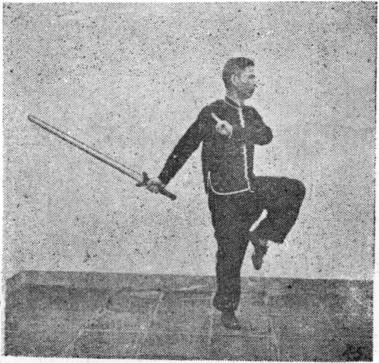
再原步将劍繞過前方变囬左手,但右手未即離開,如『過渡式乙𡇫』。
Maintaining your position, send the sword arcing forward and switch it to your left hand, your right hand not yet letting go. See photo 45b:
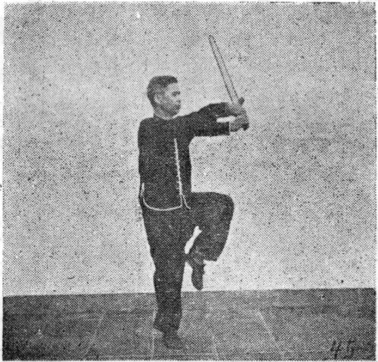
将左脚落於正面跨虎步,左手持劍斜貼臂外,右手劍訣橫掛於頭上,如『定式𡇫』。
Then your left foot comes down to make a forward-pointing sitting-tiger stance as your left hand takes the sword and holds it diagonally behind your left arm, your right hand now making the swordsman’s hex, which is hung pointing sideways above your head. See photo 45c:
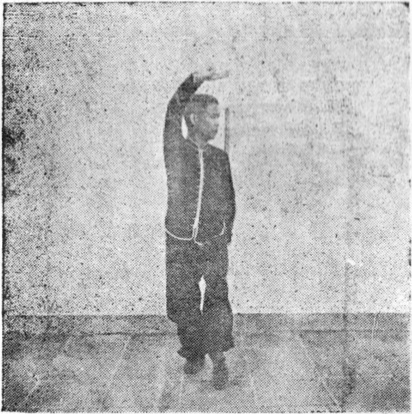
功用;
Application:
劍已還原,别無功用可言。
The sword is simply returned to its original position, and so there is no application to speak of.
第四十六式 立正中平式
Posture 46: STANDING STABLY AT ATTENTION
説明
Explanation:
循上式,左前脚退後成立正之勢,訣由上而下,乃成中平之勢,如『定式𡇫』。
Continuing from the previous posture, your left foot retreats to make a posture of standing at attention, your swordsman’s hex going downward from above, returning you to the posture of standing stably. See photo 46:

功用
Application:
練劍至此作結矣,如表演於觀衆之前,必一鞠躬禮,若練習時可完矣。
This posture concludes the set. If you are performing it in front of an audience, you should add a bow, but if you are simply practicing, this can be the completion of the set.
–
子午劍內可互相對擊之法
PARTNER TRAINING OF THE TECHNIQUES IN THE SUNDIAL SWORD SET
吾國古之武士舞劍法,頗為普遍,有酒席讌前,單人單劍舞,有單人雙劍舞,更有兩人持劔對舞,對舞之法,亦有文舞与武舞之别,文舞;則祗限於各人用劔法之原理,互相作逺距離之劈刺,若武舞;則含有甚強之爭鬥性質,或更以性命相搏者,如楚漢争至最烈時,項羽設讌於鴻門,特邀漢王赴宴,席間范增故使項莊舞劍於讌前,時欲逼近漢王席前,以出其不意而殺之,項伯洞燭其好,亦拔劍上前,故與對舞,以廽護漢王,漢王因此得脱斯危,亦即項莊舞劍,志在沛公,富有厯史性之一幕也。
子午劍,既可单人練習,亦有雙人對子午劍之可練,茲為求使練習者,易於認識劍內法則之大略起見,特將劍內之法擇数式,而互相對練,若其他之法,亦可由此領悟其要點矣。
衣綑白邊者為黃漢勛簡称甲方
全黑衣褲者為韋漢生簡称乙方
The ancient warriors of our nation commonly performed “sword dances” in front of the guests at a banquet. There was the dance of one person holding one sword, one person holding two swords, or two people each holding swords. The partner version is further divided into two types of dance: civil and martial. The civil dance is confined to each person demonstrating sword techniques with a lot of space between them as they chop and stab. The martial dance instead involves a quality of vigorous combat, or even a fight to the death. Here is a famous example of the martial dance:
During a time of intense rivalry between the states of Chu and Han [206 BC], Xiang Yu arranged a banquet at Hongmen and specially invited the King of Han [Liu Bang] to attend. In the course of the banquet, Fan Zeng called for Xiang Zhuang to perform a sword dance in front of the guests. Xiang gradually worked his way closer to the King of Han’s seat so that he could take him by surprise and kill him. Xiang’s uncle realized what he was doing, so he drew his own sword and came forward to make it a partner dance in order to protect the King of Han, and the king was thereby kept out of danger. The idiom “Xiang Zhuang dances with his sword, but his thoughts are on the Duke of Pei [i.e. Liu Bang / King of Han]” is thus imbued with a rich sense of history.
The Sundial Sword techniques can be done as a solo practice, but also as a two-person practice. Doing it in this way causes the practitioner to easily recognize the general idea of the techniques within the sword set. Engage in partner practice with the several postures specifically selected below. The essentials of the rest of the techniques in the set can then be understood on this basis.
(The man with the white hem is Huang Hanxun. The man dressed entirely in black is Wei Hansheng. They are simply referred to in the text as Person A and Person B respectively.)
第一𡇫 説明
Explanation for scenario 1:
甲方用第三十三式之『跨虎挑寳劍』以挑對方之腕,乙方亦用第三式之『夜义探海式』自上反刺對方之臂部,如第一𡇫
Person A uses SITTING-TIGER STANCE, CARRYING A PRECIOUS SWORD (Posture 33) to do a carrying action toward Person B’s wrist. B counters with NIGHT DEMON SEARCHES THE SEA (Posture 3) to stab downward toward A’s wrist. See photo 1:
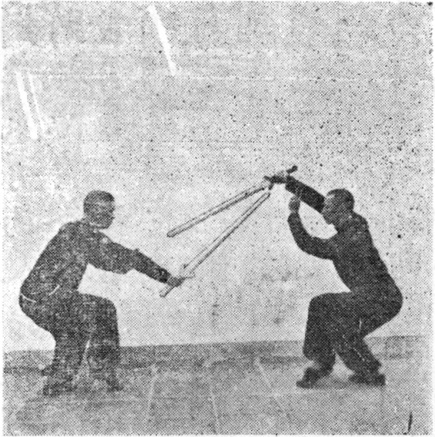
第弍𡇫 説明
Explanation for scenario 2:
甲方用第六式之『螳螂捕蝉式』橫撇對方腰部或前鋒馬,乙方亦用同式先求扑腿卸去来勢,並用橫劍以抵禦其劍,如第二𡇫
A uses MANTIS CATCHES A CICADA (Posture 6) to swing across to B’s waist or front leg. B responds by using the same posture, going into a reaching-leg stance to withdraw away from the attack and sending his sword across to resist against A’s sword. See photo 2:
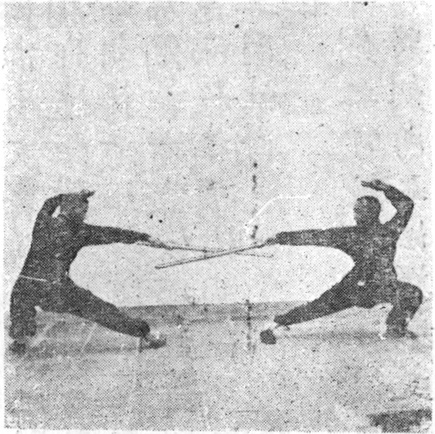
第三𡇫 説明
Explanation for scenario 3:
甲方由扑腿低勢疾一躍而起用第五式之『白蛇吐信式』刺向對方中上部乙方亦以同式之法反刺對方因此距離稍逺而消失效用焉,如第三𡇫
A quickly hops up from the low reaching-leg stance and uses WHITE SNAKE FLICKS OUT ITS TONGUE (Posture 5) to stab toward B’s middle or upper area. B responds by using the same posture to stab toward A, causing the distance between them to slightly increase and making A’s technique lose its efficiency. See photo 3:
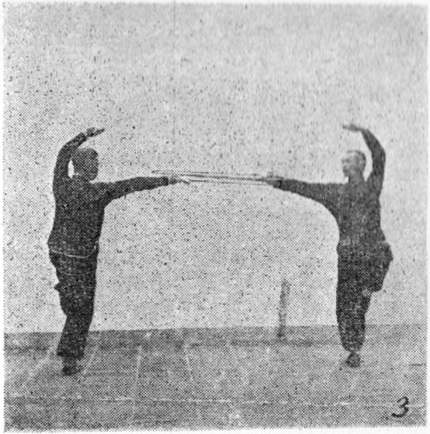
第四𡇫 説明
Explanation for scenario 4:
甲方用第二十四式之『鳳凰點頭式』以劈對方上部,乙方乃用第二十一式之『鷂子翻身式』漏劍自下反挑對方之臂与腕,如第四𡇫
A uses PHOENIX NODS ITS HEAD (Posture 24) [except in this case using a one-legged stance rather than a mountain-climbing stance] to chop to B’s upper area. B counters with HAWK TURNS OVER (Posture 21), slipping his sword underneath with a carrying action to A’s forearm or wrist. See photo 4:
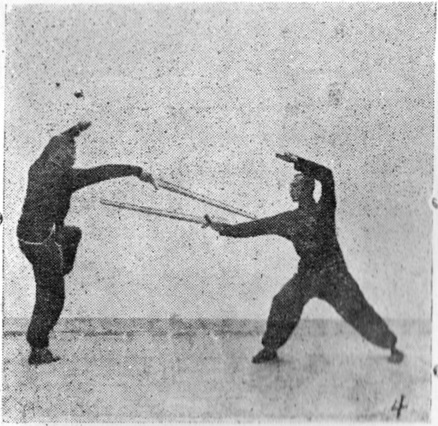
第五𡇫 説明
Explanation for scenario 5:
甲方先用第四十式之『游龍擺尾式』斜走扭馬橫刺對方之腕,乙方亦用同式徧走避過来勢並且同法反刺對方之腕部如第五𡇫
A uses SWIMMING DRAGON SWINGS ITS TAIL (Posture 40), stepping diagonally into a twisting stance and stabbing across to B’s wrist. B responds by using the same posture to step evasively and stab toward A’s wrist. See photo 5:
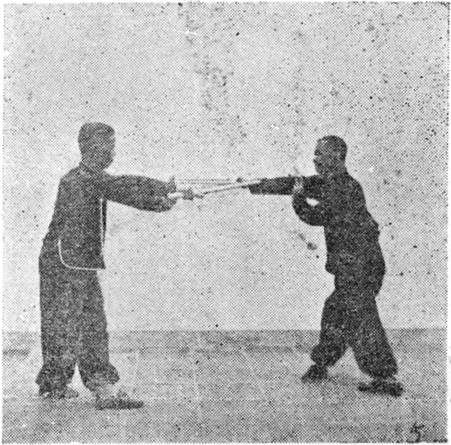
第六𡇫 説明
Explanation for scenario 6:
乙方先用第二十式之『和尚撞金鐘㳒』提步平劍疾刺對方之喉,甲方則用第二十七式之『金鈎掛玉瓶』㳒以跨虎橫劍斜斜消去来勢如第六𡇫
B uses MONK RINGS THE GOLDEN BELL (Posture 20), lifting his leg and doing a sudden level stab toward A’s throat. A responds with THE JADE VASE HANGS FROM THE GOLDEN HOOK (Posture 27), going into a sitting-tiger stance and sending his sword diagonally across to dispel the incoming attack. See photo 6:
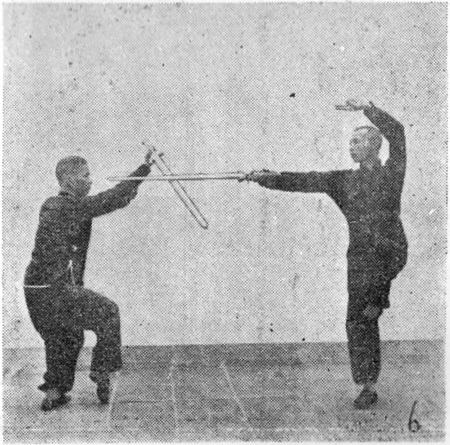
[The name of this sword set, 子午 (zi wu), is never explained in this book. Have a look at the Chinese sundial in this photo, which shows the shadow close to 午 (noon) and thus in line with 子 (midnight) above it. However, although this may help to clarify the term, we are still left to speculate on what exactly the term has to do with the contents of the set.]
– – –
[View an original Chinese edition of Sundial Sword, provided by the Ravenswood Academy.]
– – –
[Included below is a related piece from Huang’s Notes on the Mantis Boxing Art (1951).]
說劍
ON THE SWORD
古今中外之以武自鳴者,靡不以劍為是尚,自歐風美雨東來,崇尚時髦之輩,多數典亡宗,不談劍法則已,否則開口泰倫包華,閉口某明星,其實西洋劍法,多出自希臘古國,其法固利用身軀偉岸,施展渾身蠻剛,且劍身單薄而長,圈挑之法甚少一見,互相鬥擊之時,碰撞之聲達於四野,若我國之鬥刀者焉。
我國之有劍術早在若干千年前,雖書生之流亦以身佩一劍以為威武,試觀孔門弟子之中,亦不鮮佩劍者,故武術界有稱之曰文劍,陣上殺敵者謂之曰武劍。
讌前對舞與夫女子所舞而以笙歌調協者亦屬文劍之一。
據小說家所言古之所謂寶劍,能於驚險之前,自動出匝以報警者,蓋其戾氣所聚,感兆於先耳,又謂劍鋒能吹毛斷鐵,是眞是假,姑不具論,由此可知中國劍術有深長之歷史也。
百日刀,千日槍,萬日劍古有明訓,可知練劍之不易,余雖半生練武,亦未敢言劍,謹以所知為談而已。
羅師云劍有八法,删、砍、劈、刴、挑、撩、刺、圈是也,除精研八法之外尚須腰活,肩鬆、腕柔而有力,步法輕凌,頭腦冷靜,缺一不可,練劍先練訣,此一訣字雖無玄妙,至少亦得組訣合法,前後左右與劍平衡,毋使姿態有所偏倚,尤比單劍術之左手更難也,術語有云棍無兩響,劍無相碰,斯為上乘,蓋此語實指鬥劍而言,若雙方劍法高明,兩無所乘,雖劇烈鬥爭之中,亦無相碰之理,劍而有聲則勝敗立判,鬥劍之初步功夫,勿使腕與肘之間有曲形,苟有曲狀便易為敵所算,最高原理則變化無窮,忽開忽合,收閉如意,瞻前顧後,左右相盼,高來低挑,低來高點,無踪可追,無跡可尋,天地國親師五行並濟,若太極之包羅,如六合之放縱,劍不過腦,自古已然,毋以劍作刀致貽方家之笑,後之學者其勉之哉。
In ancient times and modern, in both China and abroad, all martial traditions have venerated swords. Ever since Western cultural influence [“European wind, American rain”] spread to the East, respect for our own traditions has mostly been lost. If we do not talk about our sword art, it will fade away, in the same way that once people start talking about Tyrone Power, other actors get forgotten.
Western sword methods, which mainly have their origins in ancient Greece, are suited to those who have an imposing physique, expressing a barbaric toughness in every part of the body, while the body of the sword is thin and long. The techniques of coiling and carrying rarely manifest. During combat, the sound of the swords clashing against each other rings out for miles around, more similar to our nation’s saber combat.
Our nation’s sword art goes back several thousand years. Even scholars wore swords to exude martial prowess. Note that among the disciples of Confucius, many of them wore swords. The martial arts world calls this kind of decorative sword a “civil sword”, whereas a sword that is for killing enemies in battle is called a “martial sword”. When swordsmen and swordswomen performed sword dances in front of a banquet, choreographed to music, this was also a kind of “civil sword”. According to novels, what ancient people called “precious swords” could be electrifying to behold. As soon as one was drawn from its scabbard, it filled people with a sense of foreboding. It is also said that the sharpness of the sword could shave away hairs and slice through iron. It is still hard to tell the truths from the falsehoods, but it is obvious at least that the Chinese sword art has a long history.
“It takes a hundred days to learn the saber. It takes a thousand days to learn the spear. It takes ten thousand days to learn the sword.” Ancient people had wise standards. They were able to understand that training with a sword is not easy. Although I have spent half my life practicing martial arts, I still do not feel qualified to lecture on the sword art and can only comment on the little that I understand. So here instead are some things that Master Luo himself said on the subject:
In the sword art, there are eight techniques: wiping, slashing, chopping, cleaving, carrying, raising, stabbing, and circling. Beyond these eight techniques, your waist has to be lively, your shoulders have to be loose, your wrists have to be supple yet strong, your footwork has to be nimble, and your mind has to stay calm. You must not be lacking any of these things.
To train with the sword, you must first train your swordsman’s hex. Although this hex has no actual magic, it performs the trick of getting you to properly execute the techniques. It balances the position of the sword to the front and back, left and right [as well as up and down] keeping your posture from being overcommitted in any direction. Using the left hand is far more difficult when performing with the single sword [than with double swords]. [The second edition of Notes (1959) alters two characters in this sentence, resulting in this rendering: “(Figuring out what to do with the left hand) is more difficult than the right hand, which is occupied with holding the sword.”]
There is a saying in the art: “The highest level is when your staff connects with his staff silently, and when your sword does not touch his sword at all.” The idea in this saying is that if two swordsmen are both at the highest level, then even if they are having a fierce fight, they will still follow this principle of not touching. As soon as there is any sound of the swords making contact, victory and defeat have been determined.
In the beginning of training in sword fighting, do not allow your wrist or elbow to have a noticeably curved shape. If they are curving, it will be easy for the opponent to anticipate what you are about to do.
The supreme principle is to transform endlessly. Suddenly open and suddenly close, sealing him off as you please. Observe in front, behind, and to the sides. If he attacks high, carry from below. If he attacks low, tap from above. Leave no trail for him to follow, no trace for him to find.
The five elements work together – the sky and the ground, the nation and the family, and the soldier – like the taiji concept [i.e. cooperation between opposites] or like the dimensions of the “six unions” [front/back, left/right, up/down].
The sword is all in the mind. Since ancient times, this has been so. Do not use the sword as though it is a saber, which would only invite the laughter of masters. Students, you will have to try harder than that!
–
–
–
